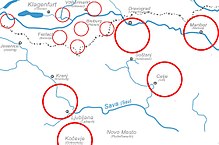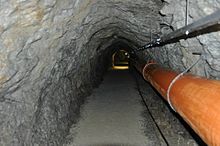Bleiburg repatriations
In the week after the German Instrument of Surrender, which marked the formal end of World War II in Europe, collaborationist forces in Yugoslavia continued to battle the Partisans to avoid encirclement and keep escape routes open.[28][29] It established a concentration camp system, the largest of which was Jasenovac,[30] where 77,000–100,000 people were murdered, the majority women and children, primarily Serbs, Jews and Roma, but also anti-Fascist Croats and Bosniaks.[43] Germany, Italy, and Hungary carved up Slovenia, and set out to entirely wipe out Slovenes as an ethnic group, through mass expulsions and forced assimilation,[44][45] which the Slovenian historian Božo Repe describes as ethnocide.[74] Winston Churchill highlighted the strength and importance of the Partisans and advised the Yugoslav government to reach an agreement with Tito,[75] whose forces generated an appeal among all ethnic groups.[83] In August 1944, he founded an army unit called the People's Defence Corps of Yugoslavia (Korpus narodne odbrane Jugoslavije, KNOJ), whose explicit assignment was to "liquidate Chetnik, Ustaša, White Guard and other anti-people gangs".[84] With the growth of the Partisans, who provided Croats an alternative that appeared more in Croatia's national interest, and the general dissatisfaction with the Ustaše and Nazi German authorities, the NDH had serious difficulties in mobilizing new troops.As the path led to Partisan-held territory, and Đujić did not trust Pavelić due to earlier examples of the Ustaše killing Chetniks passing through the NDH, he took an alternate route in agreement with the local Wehrmacht commanders.[114] Following the capitulation of Germany, Tito issued an address via Radio Belgrade on 9 May calling upon all armed collaborators to surrender, threatening "merciless response" from the people and the army should they refuse to do so.Parts of the columns that had weak or no protection were attacked by the Partisans - on 12 May, Politika carried Yugoslav Army reports of 15,700 prisoners of war in Maribor, Zidani Most, Bled, Jesenice and elsewhere.On the night of 13 May, the elite HOS infantry units, commanded by General Rafael Boban, managed to break through the Partisan blockade and the column moved west through Ravne na Koroškem and Poljana towards Bleiburg.Teodor Pavić, described as a NDH "courier", wrote that the Partisan forces began strafing the crowd in the Bleiburg field with machine guns and shooting them individually.[97] Croatian historian Martina Grahek Ravančić[147] wrote that the complete extent of the casualties sustained by the NDH column at Bleiburg on the day of the surrender was not described in any available sources.[148] Strle and Milan Basta claimed that as Ustaša forces tried to make a breakthrough at the north side of the valley, three British tanks moved to stop them, reportedly resulting in several casualties.[145] Tomasevich writes that these kinds of unconfirmed reports of British military involvement, coupled with the legitimate acts of repatriation, were subsequently exaggerated by Ustaša supporters, particularly in the Croatian diaspora.At the time of the Axis retreat from occupied Yugoslavia, the British V Corps of the Eighth Army was stationed in southern Austria, which was within the area of authority of Field Marshal Harold Alexander.Since then, the Bleiburg Honorary Guard (Počasni bleiburški vod), an association founded by former members of the Ustaše,[218] organized an annual commemorative event, together with the Catholic Church in Carinthia.In 1991, the Croatian government created the Commission for Determining Wartime and Postwar Victims of the Republic of Croatia, led by Vice Vukojević, a member of the Bleiburg Honor Guard, who claimed Jews ran the Ustaše Jasenovac death camp.In addition, on a separate route there were around 17,000 members of the Slovene Home Guard, the Serbian Volunteer Corps, Chetniks and some smaller NDH army units, together with around 10,000 Slovenian civilians.[282] For the 60th anniversary commemorations in 2005 a large crowd was in attendance, with speeches by Croatian parliamentary speaker Vladimir Šeks and head of the Muslim Community of Croatia, Mufti Ševko Omerbašić.[289] In 2009, Croatian President Stjepan Mesić criticized the Parliament's representatives who did not react to people in the crowd displaying Ustaše iconography at the commemoration, which is ostensibly illegal in Croatia, at a state-sponsored event.As Croatian academician Vjeran Pavlaković, an assistant professor in the Department of Cultural Studies at the University of Rijeka, writes in Deifying the Defeated Commemorating Bleiburg since 1990,"The blurring of the past and the present is an integral part of the Bleiburg commemorations; not only do the participants dress in Ustasa uniforms, display Ustasa insignia and iconography, and sell paraphernalia associated with the NDH and its leaders, but there is an active discourse about the Croatian War of Independence accompanied by images of heroes (as well as individuals guilty of war crimes) from the conflict in the 1990s."Pavlaković concludes that "[T]he effectiveness of Bleiburg to act as a site of memory can be attributed to the fact that it represents both a traumatic past, as well as a moment of rupture, or historical discontinuity.The danger of presenting the victims of Bleiburg exclusively as martyrs for the Croatian state, however, is that the reality of the NDH regime and the crimes it committed are ignored in the new, revised narrative of World War Two.[309] In July 2020, the lower house of the Austrian Parliament adopted a resolution calling on the Ministry of the Interior to consider banning the commemoration in Bleiburg, because of the display of Ustaše symbols.[312] In November 2021, Karl Nehammer, then the Austrian Interior Minister recommended that the Bleiburg commemoration in its present form be banned, because “In Austria, glorifying the terror regime is unacceptable.Responding to those who in Croatia seek to equate Bleiburg with Jasenovac, historians Ivo and Slavko Goldstein wrote: “Jasenovac…was primarily a genocidal crime of mass murder of civilians for the sin of their birth in another religion or nationality”.As part of Bleiburg, those killed were almost exclusively disarmed soldiers, combat-capable men”[2] Regarding Tito's responsibility for the actions of the Partisans at the end of the war, Croatian lawyer Dominik Vuletić wrote: "...it should be mentioned that at the time of the Bleiburg events and the death marches that followed, he was the Prime Minister (DFJ), Minister of Defence, General Secretary of the Communist Party and the Supreme Commander of all Yugoslav Armed Forces, so de facto and de iure he had control over all the forces and was the most responsible individual in the country."[84] On 13 May, Tito dispatched a handwritten telegram to the supreme headquarters of the Slovene Partisan Army that arrived on 14 May, prohibiting "in the sternest language" the execution of prisoners of war and commanding the transfer of possible suspects to a military court.[331] Swiss historian Michael Portmann writes, "The responsibility for “Bleiburg” to a vast extent rests with Pavelić and the Ustaša regime itself: The bloody terror of ustaše against the Serbian population (coercive conversions, expellings and mass killings), the Croatian state's determined alliance with Nazi Germany and - last but not least – the order by Pavelić not to surrender but to withdraw under battle to the Austrian border have to be stated as reasons for the indeed brutal Partisan retaliation".A 2004 Croatian film, Long Dark Night (Duga mračna noć), directed by Antun Vrdoljak, covers the wartime in a Slavonian village from 1941 to 1945 and post-war events in Slovenia.















World War II in YugoslaviaRevengeatrocities, collaborationoccupationUstašeSlovene Home GuardGermanBosniakSloveneatrocities and collaborationBritish ArmyYugoslav PartisansSummary executionsmassacresdeath marchesIstrian–Dalmatian exodusPurges in SerbiaBloody Christmas (Macedonia)JazovkaGračaniHuda jamaKeva's pit caveMaceljKočevski RogPečovnikOsijekTeharjeSterntalValpovoAllied-occupied AustriaYugoslaviaend of World War II in EuropeWorld War IIannexed or occupiedcollaboratorsYugoslav ArmyAlliedBritishlabor campsCarinthianBleiburgIndependent State of Croatiapuppet stateGerman-occupied YugoslaviaCroatian Armed ForcesArmy Group EXV SS Cossack Cavalry CorpsChetniksMontenegrin National ArmyGerman Instrument of SurrenderKlagenfurtbreakup of YugoslaviaCroatianJasenovac concentration campLeon RupnikGregorij RožmanErwin RösenerKingdom of YugoslaviaTripartite PactBelgradecoup d'étatAdolf Hitlerinvasion of YugoslaviaHungaryZagrebAnte PavelićPoglavnikceding of territory to ItalyEinsatzstaffelSS Prinz EugenFinal Solutiongenocide against SerbsOrthodox ChristianJewishJasenovacHolocaustUnited States Holocaust Memorial MuseumVladimir ŽerjavićEdmund Glaise-Horstenaugovernment of the NDHSloveniabishop of Ljubljanaleading Slovene politiciansLjubljana Provinceanti-communist unitsSlovene People's PartyRab concentration campSlovene LandsSerbiaGerman military administrationcivil puppet governmentMilan NedićRoyal Yugoslav ArmyDraža MihailovićYugoslav government-in-exilecollaborationGreater SerbiaCommunist Party of YugoslaviaMolotov–Ribbentrop PactSoviet UnionNazi invasion of the Soviet UnionJosip Broz TitorevolutiontotalitarianBelgrade OffensiveRed Armyfront in Syrmiamass killingsDepartment for People's ProtectionPeople's Defence Corps of YugoslaviaLorković–Vokić plotAlliesCroatian Home Guardregular armyamnestySlovene Home GuardsPeter IIArmed Forces of the Independent State of CroatiaUstašaMomčilo ĐujićDinara Divisionbattle of Knin8th Dalmatian CorpsSlovene People's Party.Bishop RožmanYugoslav People's Army

